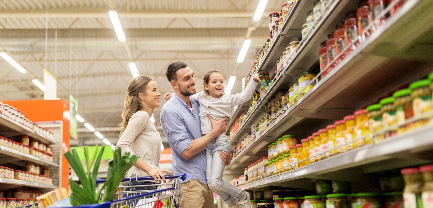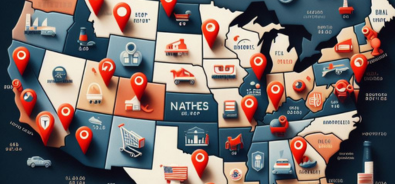

31.10.2023
The science behind Shoppers’ cart choices
Have you ever thought about what makes you choose one product over another? Why did you choose Dove Shampoo and Not Pantene Shampoo? Do you think your decision is accidental? Depending on the price? Depending on another preference?
Our apologies for shattering this conception for you, but your choices are not logical or rational. Our team gathered some of the most recent data from ShopperAI’s systems in order to examine and illuminate some of the interesting findings.
We will examine some of these findings in this article.
Differences between men and women
Time spent in front of the shelf and in the store: From data on shoppers’ behavior in front of the various supermarket shelves, in a variety of categories, we saw that the time spent in front of the shelf until a decision is made is higher among women. In other words, women tend to stay, examine and delve into products on the shelf by about 30% more than men.
In order to sharpen the impact of this statistic on our lives, it is important to understand that it takes men an average of about 20 seconds from the first encounter with the product on the shelf to making the decision whether to put it in the cart or not. For women, it takes about 30% longer. Therefore, if we multiply this with each decision at the supermarket, we are talking about an additional 20 minutes among women spending time at the supermarket. Therefore, it is not inconceivable that the average basket of women is higher than the average basket of men in the supermarket (based on sales data for 2023).
Deliberation: Who is more undecided and who is less decisive? Men or women?
How many times have you already put a product into your basket and how many shelves later have you taken it out and placed it on the nearest shelf?
Women tend to be more critical and therefore also tend to debate more between the different alternatives in the category. According to ShopperAI data, women examine the product itself more than men, it takes them longer to find the product they are looking for on the shelf. This can be explained by women’s specific choices and preferences for products they know and trust. Men, on the other hand, will be more exposed to the functionality required from the product and therefore the importance and substitutions in men are lower.
Who is rational and who is emotional? Although everyone thinks that women are more emotional than men, when shopping – this is not the case. According to ShopperAI data, women make decisions more rationally, delve into the details and while making the decision, they do not go on “autopilot”. In other words, they are less affected by price, in-depth promotion or benefit, but rely on serious and rational deliberation about the need and quality of the product. The gap found is about 35% more decision time for women than for men in various categories.
In gender categories such as alcohol, it was measured that in 90% of cases, women stopped in a category, looked and moved on without putting products in the cart. The conversion rate of men in the alcohol category stands at 2 times. We can learn from this that in categories that interest men or that serve them as a status symbol, men will behave differently compared to the other categories in the supermarket, and will even be more emotional based on sale or price. Therefore, it can be seen that the conversion rate in these categories will be double for men.
This fact is reinforced when we look at the data on supermarket snacks. In this category, there is a clear majority of men compared to women. In addition, we see a clear preference among men towards salty snacks versus sweet snacks (65% more between years). Therefore, it is quite possible that the average basket of men contains more snacks, sweets, and alcohol (products that are not mandatory products but indulgence – that is, impulse products).
In the hot drinks category, it was found that women would prefer green tea over men (+30%), while men would prefer black tea (+12%). This trend is related to the importance of health and the clear preference of women in favor of products considered healthy. This trend is growing and we see the dilemma of women in other categories versus the healthier product on the shelf.
Regret – also in the supermarket!
In category differences and insights;
When it comes to hot and comforting drinks, we see that shoppers prefer coffee but choose tea. Here, too, the health trend is kicking in and showing signs on shoppers and the feeling of regret in the face of buying coffee. In the tea category, we see an abandonment rate of 30% compared to 57% abandonment in the coffee category. Abandonment refers to holding the product and returning it to the shelf. For example, a shopper who came to the hot drink shelf in the supermarket searched for and picked up a coffee box from the shelf, but put it back in its place. The data shows that every 2nd shopper at the supermarket put the coffee back in its place and did not put it in the cart.
Speaking of the health trend and shoppers’ emphasis on a healthy shopping feeling, we see that shoppers prefer gluten-free snacks (+52.15%), meaning that when deciding on the snack category, they will prioritize gluten-free ones. In addition, darker brown chocolate packaging (+33.05%) and lighter white yogurt packaging (+25.67%) encourage more interactions, because the color of the packaging is similar to the color of the contents and therefore simulates a sense of naturalness and from there we project health on it (more similar to the natural color in nature).
When do we prioritize our health the most? It was found that those aged 45+ are more hesitant to buy unhealthy products by about 27% compared to the two lower age groups.
What is the measure of regret and the influence of the current trend on our decisions vis-à-vis snacks and other products? It was found that snacks marked with extra saltiness cause shoppers to be more interested in the snack, compared to a snack with moderate saltiness (+35.24% of the average in favor of snacks with extreme saltiness). We can attribute this to the “extra” trend born of social networks and the need to meet the growing excitement of surfers and shoppers. Thus were born new products with “extra” taste, spiciness, saltiness and carnality, which manufacturers created to adapt to the ever-increasing pace of momentary excitement and its high threshold.
Waiting for the High Holidays?
If you feel like you’re buying more, you’re right. ShopperAI data shows that during the holiday season, shoppers are more decisive, and quick in their decisions, price and sale biased, and the dilemma in front of the shelf decreases, so it is not inconceivable that the shopping basket beyond holiday hosting is also larger. The indices showed a difference of 17% compared to the weekdays.
ShopperAI helps us point out where the shopper is hesitating, lingering, choosing intuitively, or struggling and moving into frustration. All of the company’s data is collected and translated anonymously without compromising consumer privacy. The technology, developed in Israel, is based on AI and image processing tools and teaches retailers to listen to consumer behavior and desires, and thus adapt their marketing strategy and activities in order to create a win-win situation between the consumer experience in the store and the retailer’s profitability. In addition, later this year the company will make the “Smart Shoppers” app accessible, which will allow consumers to receive tips and benefits for smarter shopping.


















